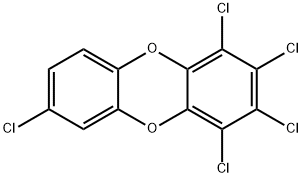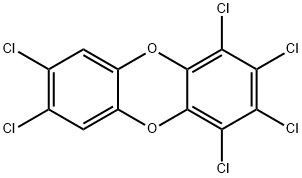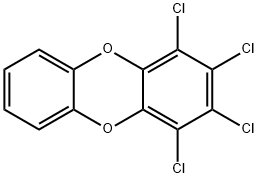TETRACHLOROCATECHOL
- CAS NO.:1198-55-6
- Empirical Formula: C6H2Cl4O2
- Molecular Weight: 247.89
- MDL number: MFCD00002190
- SAFETY DATA SHEET (SDS)
- Update Date: 2025-12-07 19:09:50

What is TETRACHLOROCATECHOL?
The Uses of TETRACHLOROCATECHOL
Tetrachlorocatechol is an intermediate in the synthesis of Heptachlorodibenzo-p-dioxin which is a toxic polychlorinated dibenzo-p-dioxin detected in domestic meat and poultry.
Definition
ChEBI: A chlorocatechol that is catechol in which all of the hydrogens attached to the benzene ring are replaced by chlorines.
General Description
Tetrachlorocatechol is a metabolite of pentachlorophenol. Acute toxicity of tetrachlorocatechol has been investigated in male and female mice.
Properties of TETRACHLOROCATECHOL
| Melting point: | 193-195 °C (lit.) |
| Boiling point: | 352.31°C (rough estimate) |
| Density | 1.8232 (rough estimate) |
| refractive index | 1.4813 (estimate) |
| storage temp. | Keep in dark place,Sealed in dry,Room Temperature |
| solubility | Dichloromethane |
| pka | 5.68±0.33(Predicted) |
| form | Solid |
| color | Off-White |
| CAS DataBase Reference | 1198-55-6(CAS DataBase Reference) |
| EPA Substance Registry System | Tetrachlorocatechol (1198-55-6) |
Safety information for TETRACHLOROCATECHOL
| Signal word | Danger |
| Pictogram(s) |
 Corrosion Corrosives GHS05  Exclamation Mark Irritant GHS07  Environment GHS09 |
| GHS Hazard Statements |
H302:Acute toxicity,oral H318:Serious eye damage/eye irritation H400:Hazardous to the aquatic environment, acute hazard |
| Precautionary Statement Codes |
P273:Avoid release to the environment. P280:Wear protective gloves/protective clothing/eye protection/face protection. P305+P351+P338:IF IN EYES: Rinse cautiously with water for several minutes. Remove contact lenses, if present and easy to do. Continuerinsing. |
Computed Descriptors for TETRACHLOROCATECHOL
New Products
Indole Methyl Resin tert-butyl 9-methoxy-3-azaspiro[5.5]undecane-3-carboxylate Boc-His(Boc)-OH 2-CTC Resin 4-Chloro-7-tosy1-7Hpyrrolo[2,3-d]pyrimidine 5,7-Dibromo-1H-indole 2,5-dichloro-N-hydroxy-4,6-dimethylpyridine-3-carboximidamide 2,2-Dimethoxy-7-azaspiro[3.5]nonane hydrochloride 4-chloromethyl-5-methyl-1,3-dioxol-2-one (DMDO-Cl) R-2-BENZYLOXY PROPIONIC ACID 1,1’-CARBONYLDIIMIDAZOLE 1,1’-CARBONYLDI (1,2-4 TRIAZOLE) N-METHYL INDAZOLE-3-CARBOXYLIC ACID 4-((2-hydroxyethyl)thio)benzoic acid 1-(TERT-BUTOXYCARBONYL)-2-PYRROLIDINONE Methyl 6-methylnicotinate 3-Pyridineacrylic acid tert-Butyl carbazate TETRAHYDRO-2H-PYRAN-3-OL 2-((4-morpholinophenylamino) (methylthio) methylene) malononitrile 3-(4-morpholinophenylamino)-5-amino-1H-pyrazole-4-carbonitrile 2,4-dihydroxybenzaldehyde 1,3-Diethyl-1,3-Diphenylurea Methyl 2-methylquinoline-6-carboxylateRelated products of tetrahydrofuran






![[Tetrabutylammonium][(Λ:,R)-(1,1μ-binaphthalene-2,2μdiolato)(bis(tetrachlor-1,2-benzenediolato)phosphat(V))]](https://img.chemicalbook.in/)

You may like
-
 Tetrachlorocatechol 95% CAS 1198-55-6View Details
Tetrachlorocatechol 95% CAS 1198-55-6View Details
1198-55-6 -
 Tetrachlorocatechol, 95% CAS 1198-55-6View Details
Tetrachlorocatechol, 95% CAS 1198-55-6View Details
1198-55-6 -
 3,4,5,6-Tetrachlorocatechol CAS 1198-55-6View Details
3,4,5,6-Tetrachlorocatechol CAS 1198-55-6View Details
1198-55-6 -
 Tetrachlorocatechol CAS 1198-55-6View Details
Tetrachlorocatechol CAS 1198-55-6View Details
1198-55-6 -
 Pyridine 99.5% HPLC /UV SpectroscopyView Details
Pyridine 99.5% HPLC /UV SpectroscopyView Details
110-86-1 -
 Dibutyl PhthalateView Details
Dibutyl PhthalateView Details
84-74-2 -
 Imidazole Spot supply, competitive priceView Details
Imidazole Spot supply, competitive priceView Details
288-32-4 -
 Thiourea 99% ARView Details
Thiourea 99% ARView Details
62-56-6
Statement: All products displayed on this website are only used for non medical purposes such as industrial applications or scientific research, and cannot be used for clinical diagnosis or treatment of humans or animals. They are not medicinal or edible.
